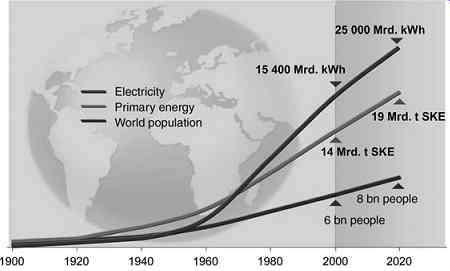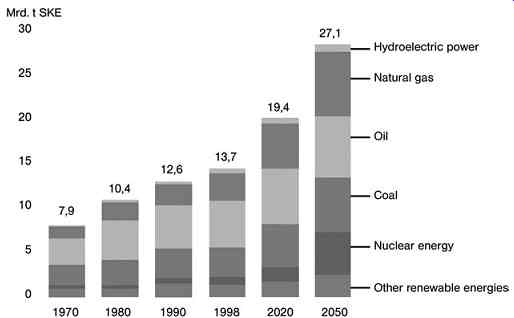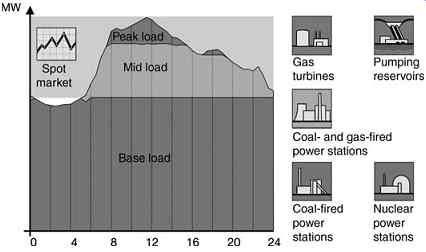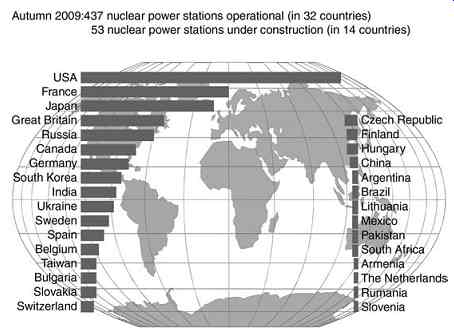AMAZON multi-meters discounts AMAZON oscilloscope discounts
1. The demand for energy
As the world's population grows, the demand for primary energy, and hence electrical energy, is growing massively with it. At the same time, the demand for individual electrical power is increasing, especially as the so-called emerging nations are seeing their energy demand soar as they strive to become industrialized. The International Energy Agency (IEA) estimates that businesses and private households will need around 60% more energy by 2030 than they do today. With their massive populations, China and India will account for two-thirds of the increasing demand forecast.
The result, 'More and more people needing more and more energy', is shown in Figure 1. Between 2000 and 2020, world population is set to increase from six to eight billion (33%), but the demand for energy is forecast to rise at nearly twice the rate, by around 62%. This increase will mean major challenges in terms of a sustainable energy supply, based on the three-pillar concept of balancing economics, ecology and society, as set at the world summit in Rio de Janeiro in 1992.

Fig. 1 Growth in global energy demand
2. Electricity generation
A number of options are available to cover this energy demand: they can basically be divided into two groups, thermal power plants and power plants running on renewable energy sources. Thermal power plants break down into oil-fired, gas-fired, lignite-fired, hard-coal-fired and nuclear power plants. Apart from hydroelectric power, the main renewable energy sources are wind power, solar energy, biomass and geothermal energy.
Different electricity production options are rated differently in environmental and economic terms, but the difference in generating power (a 1000MW coal-fired power plant is equivalent to 200 offshore or 400 onshore wind farms, for example) makes it clear that, essentially, the only way that rising world energy demand will be met is by using powerful cogeneration plants.

Fig. 2 World energy demand and coverage (WEC reference scenario)

Fig. 3 Energy supply load curve
As Figure 2 shows, even though renewable energies are set to expand enormously in the coming decades, the capacity they actually generate will only grow slightly, so that their percentage share of total electricity generated will actually fall. The forecasts by World Energy Council (WEC) and IEA also say that even after 2020, more than 70%of energy will be obtained from coal, oil and gas, and the share of nuclear power will increase considerably. As well as output, having a reliable electricity supply is also extremely important, which also shows that thermal power plants are essential. If we look at a typical day load curve as in Figure 3 - broken down into baseload, average load and peak load - it is clear that thermal power plants are needed for baseload particularly.
3. Importance of nuclear energy
In contributing towards covering world energy demand over a forecast period up to 2050 (Figure 2), nuclear energy plays a key role in generating electricity, which will mean a large number of new build projects worldwide. As the overview in Figure 4 shows, as at autumn 2009, as well as the 437 nuclear power plants already in operation, another 53 new nuclear power blocks were under construction, and another 76 new blocks were planned. The new blocks currently being built or planned mostly have (electricity) outputs from 1000 to 1600MW. (Please note: the figures given in MW below indicate electrical energy, as opposed to thermal energy, which is stated in MWth.)
Nuclear energy now provides around 15% of the electricity generated worldwide. It avoids around 2.5 bn tonnes of CO2 emissions, so it makes a major contribution towards a sustainable electricity supply which achieves the goals in terms of economics, capability and the environment to a large extent.
For Germany, which uses wind energy relatively intensively, direct comparison shows that theoretically more wind energy was installed than nuclear in 2008 (23,300MWas against 21,497MW), but nuclear generated much more energy than wind, at 148.8 TWh as against 40.2 TWh. In other words, nuclear energy generates nearly 50% of baseload electricity in Germany.

Fig. 4 Generating energy from nuclear power
Just how important nuclear energy is can also be seen from how economical it is in generating electricity. Building new nuclear power plants is relatively expensive in terms of capital costs, but the fuel costs involved (uranium), including disposal, are so low that the total cost (including disposal and end stage planning) of generating electricity is around 3-4 Euro cents per kWh. This means that nuclear power is not affected by volatile fuel prices and guarantees a reliable supply, as the uranium deposits that are worth extracting at today's prices will be enough for more than 200 years, are spread across the world and the countries they originate in are politically stable.
The world, and Europe in particular, has recognized how important nuclear energy is when it comes to generating electricity, as the many new build projects show. A number of European countries, including Finland, France and Britain, have actually been building new nuclear power plants or planning them since 2005. These newbuild projects impose different requirements on structural engineering, not just in building them, but in interim and final storage and restoration work. We will look at these tasks, with their specific safety requirements, below.